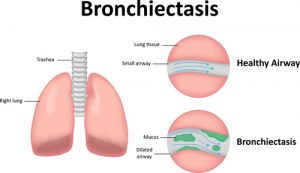 Bronchiectasis (brong-ke-EK-ta-sis) is a chronic condition where the airways are damaged and have become widened with scarred and thickened walls.
Bronchiectasis (brong-ke-EK-ta-sis) is a chronic condition where the airways are damaged and have become widened with scarred and thickened walls.
The condition can affect one section of the lung or many sections of both lungs, and usually is caused by inflammation and infection that prevents the airways from clearing mucus. As mucus builds up, bacteria can grow and the airways can become infected, making it more difficult to clear them. This can ultimately lead to the loss of lung function over time, as well as serious health problems such as respiratory failure, heart failure, and atelectasis.
People with bronchiectasis experience periods of good and bad health. The times when lungs worsen are called exacerbations. These exacerbations may increase gradually in severity over a few weeks or can subside in a few days, ultimately leading to a decline in lung function over the years. People who experience more exacerbations or who are infected by certain bacteria such as methicillin-resistant Staphylococcus aureus (MRSA) will lose lung function faster and their symptoms will be worse.
How bronchiectasis begins
Bronchiectasis usually begins with some type of damage to the lungs which might have been caused by a common childhood infection such as whooping cough or measles, or from a lung-related medical condition such as cystic fibrosis or primary ciliary dyskinesia (PCD). These disease types are called acquired bronchiectasis.
Bronchiectasis can also be congenital, meaning it may be the result of an abnormal lung development before birth. This type is much less common than acquired bronchiectasis.
There is no cure for bronchiectasis. The treatment usually includes medications to control symptoms and hydration, along with chest physical therapy.
It is important that a bronchiectasis diagnosis is made and treatment is established as early as possible to prevent more serious lung damage.
Bronchiectasis News Today is strictly a news and information website about the disease. It does not provide medical advice, diagnosis, or treatment. This content is not intended to be a substitute for professional medical advice, diagnosis, or treatment. Always seek the advice of your physician or another qualified health provider with any questions you may have regarding a medical condition. Never disregard professional medical advice or delay in seeking it because of something you have read on this website.
